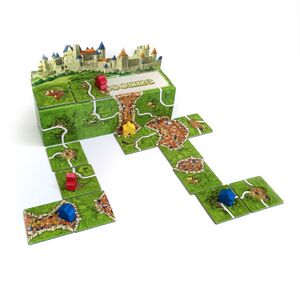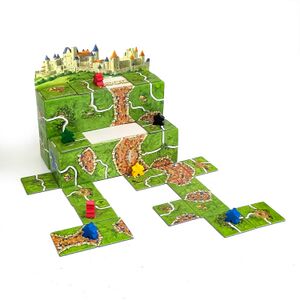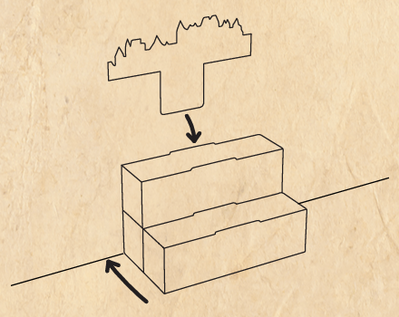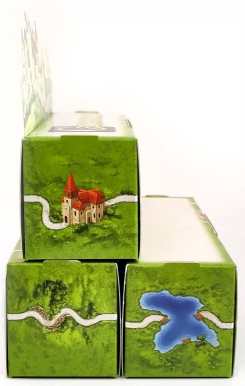3D Startlandschap

Met 3D Startlandschap kun je verschillende driedimensionale startlandschappen voor Carcassonne bouwen. Tegelijkertijd kun je de inlegfunctie gebruiken om je basisspel en mini-uitbreidingen efficiënter op te bergen.
Algemene informatie en opmerkingen
Het 3D Startlandschap en 3D Startlandschap met alternatieve indeling werden in 2023 uitgegeven door Hans im Glück.
Met elke van deze fan-items kun je verschillende driedimensionale startlandschappen voor Carcassonne bouwen. Tegelijkertijd kun je de opbergfunctie gebruiken om jouw basisspel en mini-uitbreidingen efficiënter op te bergen.
De opbergfunctie vervangt de huidige vakverdeling van de doos. Er is dan meer ruimte voor jouw Carcassonne basisspel en jouw mini-uitbreidingen. Zet de doos in elkaar (zie de hoeken van de doos) en plaats die in de kartonnen doos van Carcassonne. Vervolgens kun je de tegels van het Carcassonne basisspel en de mini-uitbreidingen in de nieuw ontstane vakverdeling opbergen door gebruik te maken van de bijgevoegde tegelhouders.
Het startlandschap vervangt de starttegel. Er zijn geen nieuwe spelregels, maar het biedt wel meer mogelijkheden om landtegels aan te leggen. De op de doos afgedrukte tegels tellen ook mee voor de puntentelling. Je kunt tegels op en rond de doos aanleggen volgens de gebruikelijke spelregels. Behandel het burcht-panorama hetzelfde als de rand van de tafel.
Speelmateriaal
| 3D Startlandchap | 3D Startlandchap met alternative opbergvakken |
|---|---|
|
|
|
|
|
|
|
|
|
|
|
|
|
|
Spelregels
Voorbereiding
Doe de de normale starttegel terug in de doos.
Place the landscape on the edge of the table, so that you don't place tiles behind the starting landscape during the game and everyone can see all the land tiles without restrictions. Place 1 or 3 empty boxes on the table with the open side down. Now you see a small gap on each of the long sides of the box. Put the castle panorama into one of these gaps. Make sure that the panorama is between two layers of paper and that the illustration is facing the bottom of the box. If you are using all three boxes, stack them together to form a staircase. The stacked "backs" at the edge of the table do not have to form a matching landscape.
If you stack the starting landscapes on top of each other, we recommend moving the top box a few millimetes forward for more stability.
Spelverloop
1. Placing a tile
When you draw a tile, you place it according to the usual rules. If the tile is placed on the starting landscape boxes, it will have to match the edges hinted on the box, except for the rear side. [1] Likewise, any tile placed next to a vertical face will have to match the edges on the landscape.
The castle panorama should be treated the same as the edge of the table. By default, it does not complete features (roads, cities, monasteries). [2]
Reminder:
- Roundabouts and bridges do not close roads.
- Lakes close roads.
2. Placing a meeple
The rules for placing meeples are unchanged from those in the base game.
Voetnoten
Kijk op de Pictogrammen pagina voor uitleg over en licensering van de pictogrammen.
- ↑
 As clarified by the item author at Essen Spiel, the boxes include edge hints to avoid blank areas due to production differences. The edge hints on the rear part of the boxes placed in the 1-box or 3-box Starting Landscape should not be considered as restrictions. The side touching the castle panorama may admit any edges, and the rear part of the front box in a 3-box Starting Landscape should follow the edge restrictions defined by the vertical face of the box on top.
As clarified by the item author at Essen Spiel, the boxes include edge hints to avoid blank areas due to production differences. The edge hints on the rear part of the boxes placed in the 1-box or 3-box Starting Landscape should not be considered as restrictions. The side touching the castle panorama may admit any edges, and the rear part of the front box in a 3-box Starting Landscape should follow the edge restrictions defined by the vertical face of the box on top.
![]() Vraag: Should the tiles placed on the 3D Starting Landscape consider the edges as printed on the side with the castle panorama?
Vraag: Should the tiles placed on the 3D Starting Landscape consider the edges as printed on the side with the castle panorama?
Antwoord: No, the rear side can accept any tile edges. The edge hints where included to avoid blank areas due to production differences. (10/2023)
In the case of monasteries, no official clarification was provided by Hans im Glück beyond the suggestion of using house rules. (4/2023)
- Completed monasteries should score 9 points during the game as usual.
- Uncompleted monasteries should score 1 point for the monastery and 1 additional tile per adjacent tile as seen from above.





